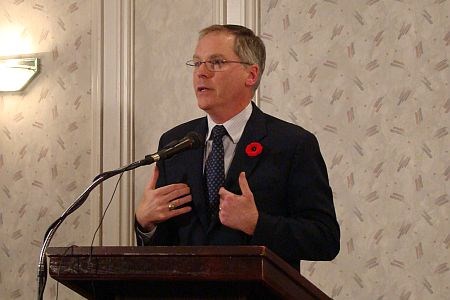The battle over harmonized sales tax made its way to Northern Ontario on Nov. 4. At a press conference in Sudbury in front of the Ontario Road Builders’ Association, Minister of Revenue John Wilkinson spoke about the benefits of a harmonized sales tax (HST) system, which is scheduled to come into effect July 1, 2010.
“We’re coming out of the worst global downturn in 80 years,” said Wilkinson. “That’s why we’ve decided we need to take bold action to ensure that we’re giving our business community the tools they need for robust growth.”
The harmonized sales tax is part of the McGuinty government’s plan to radically change the Ontario tax system by marrying the GST with the PST to create the federally administered HST at 13 per cent.
Wilkinson said harmonized sales tax will encourage economic growth in Ontario during the global recession and give the province’s economy a leg up on other markets.
British Columbia has also expressed interest in adopting a system of HST, which is already used in some form in 130 countries and Canada’s Atlantic provinces. It is not in use in the U.S., Canada’s largest trading partner.
“We believe we will be giving our companies here a structural competitive advantage on the world stage,” said Wilkinson, who also spoke in Thunder Bay, Nov. 5.
The government’s plans, as outlined in the 2009 budget, are to lower income tax rates to compensate for the higher HST levels.
The HST will have fewer goods and services exemptions than the current two-tax system. It’s sparked debate from industry groups and politicians.
The Canadian Federation of Independent Businesses has stated harmonization will save business $100 million per year in reduced red tape and the Ontario government contends administering one tax will save the province’s businesses $500 million. However, not all industries are in favour of the new tax.
The Ontario Home Builders’ Association opposed the tax, saying it could add tens of thousands to the cost of a new home. Originally, the tax was planned to be applied to the purchase price of a home over $400,000.
However, recent changes to the tax have eased some of their concerns. Under the new system, HST will only apply to the amount the home is over $400,000, not the entire purchase price.
The Ontario Road Builders’ Association supports the HST.
Earlier in the day before Wilkinson arrived in Sudbury to tout the government’s plans, the revenue minister was in Niagara-On-The-Lake to announce an independent study at school of public policy at the University of Calgary stated the HST will help make Ontario a more attractive place to do business.
The report, released by Prof. Jack Mintz predicted the blended tax, coupled with the additional tax cuts in the 2009 provincial budget, will create $47 billion in investment in Ontario, equating to 591,000 new jobs during the next 10 years.
But both the Ontario Conservatives and the NDP oppose the tax.
NDP Nickel Belt MPP France Gelinas said in the short term, the HST will kill 10,000-40,000 jobs in Ontario make the average taxpayer pay more when they are already cash strapped in the current economy.
“It makes no sense,” she said.
“The last thing we need is something that will kill jobs and people’s ability to participate in the recovery and business opportunities.”
Because the HST is revenue neutral, its revenue will not be used for services or to eliminate the province’s massive $25 billion deficit. This serves to give big business a break without helping the average person, said Gelinas.
“There is no reason to give tax cuts to profitable businesses. If you were able to make money through the recession, you are the last one the government needs to give a gift to.”
One of the major issues the Liberals and New Democrats disagree on is how much of the savings to the businesses will likely be passed on to the consumer.
Wilkinson cited studies from the Ontario Chamber of Commerce that as much as 80 per cent of the money business save on taxes will be passed on directly to the consumer. Gelinas says she doubts this will be the case.
“History has shown us that those savings are never passed onto the consumer. We basically see it as the wrong tax at the wrong time.”




